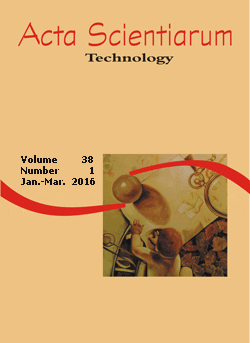<b>Effect of reversal of the flow direction on hydrodynamic characteristics and plants cultivated in constructed wetland systems
DOI:
https://doi.org/10.4025/actascitechnol.v38i1.27864Palavras-chave:
clogging, wastewater treatmentResumo
The objective of the present study was to evaluate the effect of reversal of the flow direction, when used the surface flow as an operating criteria, on hydrodynamic characteristics and plants grown in horizontal subsurface-flow constructed wetland systems (HSF-CWs). For this purpose, six HSF-CWs were used: two non-cultivated (HSF-CWs 1 and 4), two cultivated with Tifton 85 grass (Cynodon spp.) (HSF-CWs 2 and 5) and two cultivated with Alternanthera (Alternanthera philoxeroides) (HSF-CWs 3 and 6). It was made a reversal in the flow direction of the HSF-CWs 1, 2 and 3. The reversal of the wastewater flow direction was performed when the superficial flow of the wastewater applied (SF) reached 50% of the length of the HSF-CWs. There was a single reversal for each system, on different dates. Reversing the flow direction promoted distinction on the dry matter yield of Tifton 85 grass. This was not observed in HSF-CWs cultivated with Alternanthera. The reversal of the wastewater flow direction promoted, in principle, the extinction of the SF advance in the HSF-CWs, but did not prevent its return. Waiting for the SF to reach 50% of the length was not the best criterion for reversing the flow direction.
Â
Downloads
Downloads
Publicado
Como Citar
Edição
Seção
Licença
DECLARAÇíO DE ORIGINALIDADE E DIREITOS AUTORAIS
Declaro que o presente artigo é original, não tendo sido submetido í publicação em qualquer outro periódico nacional ou internacional, quer seja em parte ou em sua totalidade.
Os direitos autorais pertencem exclusivamente aos autores. Os direitos de licenciamento utilizados pelo periódico é a licença Creative Commons Attribution 4.0 (CC BY 4.0): são permitidos o compartilhamento (cópia e distribuição do material em qualqer meio ou formato) e adaptação (remix, transformação e criação de material a partir do conteúdo assim licenciado para quaisquer fins, inclusive comerciais.
Recomenda-se a leitura desse link para maiores informações sobre o tema: fornecimento de créditos e referências de forma correta, entre outros detalhes cruciais para uso adequado do material licenciado.



















